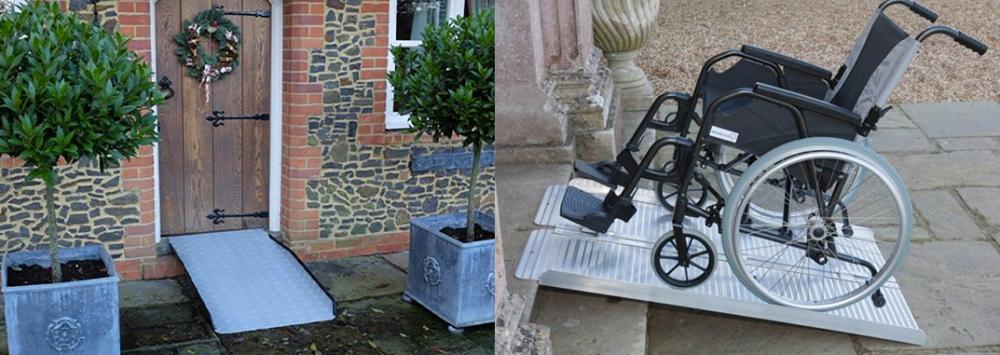
Guide to Maintaining Wheelchairs and Wheelchair Ramps
Sally Madeley-Carr, OT12 May 2020
Wheelchairs need to be consistently maintained if they're to last and remain safe to use. If it is being used on a weekly or daily basis, it's helpful to make a checklist of areas of the chair to consider.
Maintaining your wheelchair is fundamental both to its safety and performance. Whether you bought it from Essential Aids or another mobility shop, it's worth running down the list and making sure everything is covered.
Later we'll come on to maintaining things like a rollator or wheelchair ramp.
Cleaning
The number one priority for ongoing wheelchair maintenance is to keep it as clean as possible. If it is used outside, it will pick up dirt and debris from the environment, which can build up on the moving parts, potentially causing damage or safety issues.
It's especially important to make sure the brakes and wheels are both clean and in full working order.
Cleaning wheelchair upholstery
In most cases, it's effective to clean wheelchair upholstery with hot water and soap or mild detergent. You should try to rinse out as much of the soap as you can and air dry the chair if possible. Remember that all the time it is drying you won't be able to use it, so bear this in mind before you start.
A damp sponge is useful for the job, along with a rag or towel to wipe-dry as much of the moisture as possible. Ideally, drying the wheelchair outside in the sun or wind is the best solution.
Cleaning the frame's tubing
Whether the wheelchair's frame is steel or aluminium, soap and water is the first method of cleaning. Again it's best to tackle this before a significant amount of debris has built up.
Using a rag with some WD40 on the tubing may also be a good idea. As well as dissolving dirt and grime, it also leaves a protective layer going forward.
It's wise to be as thorough as possible with the all tubing, even the hard-to-reach parts. To this end, if it's possible to raise the wheelchair up, maybe putting it on a table or bench surface, then it's a good idea. This will help you reach the bits you might otherwise struggle with.
Once happy with the cleanliness of the tubing, some people like to apply a layer of car wax or polish. Like WD40, this gives the finish some protection.
Steel frames in particular should be dried off as thoroughly as possible after cleaning with water. These frames have the tendency to rust, so take as much care as possible to guard against it. Again, WD40 will help in this respect.
Aluminium frames corrode much less.
Cleaning wheelchair wheels
If the chair is a self-propelled model with large rear wheels for pushing, you might want to pay these particular attention. Grease particles can build up on the rim surfaces, so it makes sense to try to remove it.
One useful tip is to try an alcohol based cleanser, which you can just wipe on with a cloth. This should return the rim to its original state.
As you clean the push-rims, you might find the odd piece of damage to the metal itself. Collisions with kerbs and other objects can lead to nicks and scrapes, which in some cases turn into sharp edges.
With the force required to push the chair, it's possible that these could cut your hands or fingers.
When cleaning, it's worth paying attention to anything like this and dealing with it. You can use sandpaper to rub down this type of damage. This should rub out any sharp edges and make the rims safe to use once more.
Regarding the inner rims onto which the spokes attach, it's wise to treat these the same as the tubing and rub it down with WD40. This can be an area which is prone to accumulation of grime, so it's important to pay it special attention. The spokes themselves can also be wiped down in this manner.
It is also worth cleaning the tyres themselves. These pick up small pieces of debris which can ingrain itself within the tread or the material of the tyre itself. Give the tread a thorough scrub with a mild bleach solution and then wash it off with soap and water. This may have the effect of reducing the 'shine' which some tyres develop as they age and can harm their traction.
If your hands are coming into contact with the tyres as you push, returning them to something like their factory condition can make a difference both to their feel to the touch and their performance.
Lubricating moving parts
Each wheelchair will have different moving components and it's important to check the specific user-manual before adding any oil or lubricant.
Brakes are obviously an important part of any wheelchair, so it's critical to give them regular attention. Ensure the mechanism is working smoothly and is locking on the wheels in the way required. Clean any debris away from the contacting surfaces.
Using a 'dry' lubricant for parts like brake hinges makes sense. These lubricants are called 'dry' but don't in fact appear that way to the naked eye. They're available as sprays or in small bottles but are in fact in a technically solid state and keep mess to a minimum.
A mobility shop, or a local bike shop or DIY centre will usually have a range of dry lubricants which are great for wheelchairs.
Types of lubricant which are effective for a wheelchair's moving parts include Teflon-based and graphite-based dry lubes. These don't leave greasy surfaces but are great for wheel axles and other moving parts.
Be careful though, the graphite versions do create noticeable black marks.
Transit wheelchairs often have swivelling caster-style wheels at the front. These need regular lubrication to ensure they are able to twist as designed, allowing the user to easily change direction.
Screws, nuts and bolts
Every couple of months, especially if you are using your wheelchair a lot, it's worth giving all the fixings a once-over to make sure nothing is coming loose.
It is possible that over time this might happen, with the chair being folded down and back up again, and suffering small impacts along with general wear and tear.
Make sure you have the correct gauge spanners and screwdrivers to make sure everything is secure and tight.
Wheelchair ramps
Maintaining wheelchair ramps is much easier than the chairs themselves but they still need attention from time to time. If the ramps fold down, it's important to ensure the hinges are well oiled.
For this you can use conventional grease but like the moving parts on wheelchairs, one of the dry lubes or WD40 is probably better. As you will likely be picking up the ramp, folding it up and putting it in the boot of a car, it's best to keep it as grease-free as possible.
Any aluminium surfaces should occasionally be wiped down with a drag and WD40. Abrasive non-slip surfaces should be periodically cleaned with soap and water, to stop the build up of grit and dirt which might have an adverse effect on wheel traction.
A portable wheelchair ramp may be just one fixed rigid unit, folding or telescopic. As with the hinges on folding ramps, the sliding mechanism within telescopic ramps needs regular lubrication to prevent it starting to catch.
This type of wheelchair ramp is usually supplied in two sections and is frequently used for transferring chairs into vehicles. Called 'channel ramps', each ramp has a high raised rim which prevents the wheels from slipping off the sides. Typically they also have non-slip material manufactured into the flat surface which makes contact with the wheels.
Having them in two parts means they are easy to lift and store, but again they usually require handling, so it's helpful if you can keep the grease off them. Again, either a teflon or graphite dry lube is an excellent option for the sliding metal sections.
Some ramps also feature rubber or plastic 'feet' which make contact with metal surfaces. These are often found on ramps suitable for accessing boots of cars. Again, it makes sense to clean these feet of any debris, to make sure they retain their high-friction properties and avoid slipping.
Maintaining other metal mobility equipment
As a specialist online mobility shop, Essential Aids not only supplies high quality wheelchairs and ramps, but also a wide range of other aids like rollators and walking frames.
It is inevitable that over time certain components may loosen, so it's important to check over this type of equipment to make sure nuts and bolts are secure.
In the case of rollators, brakes should be regularly checked, along with the wheels and tyres.
You may be able to take your rollator into your local mobility shop and ask them to ensure the brakes are safe and make any necessary adjustments. A bicycle mechanic should also be able to help with this, if the brakes are the cable design found on push-bikes.

Sally Madeley-Carr, OT
Sally qualified as an Occupational Therapist in 1996 and is a well-respected professional in the field of rehabilitation equipment and living aids. She has worked in private practice and within the NHS, developing a broad experience with adults and children. Click here for Sally's registration with the Health and Care Professions Council. The HCPC regulates health, psychological and social work professionals in the UK.